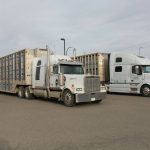“Another day older and deeper in debt”.
These famous words from the 1955 Tennessee Ernie Ford songSixteen Tonsdescribe the financial situation of coal miners. But they ring true for many Canadian families today.
A recent study by the Vanier Institute shows that the debt load of the average Canadian household has gone over the $100,000 mark for the first time.
At the end of 2010, Canadian families owed $100,879 on average. The debt-to-income ratio is at a record 150 percent, up almost 80 percent from two decades ago. That means that for every $1,000 Canadian families earn after tax, they now owe $1,500. Mortgages account for two-thirds of that debt while personal loans and credit card debt make up the rest.
Read Also

Surviving a bad harvest day sometimes requires a little luck
Producer and writer Kevin Hursh shares a day of three potentially disastrous incidents as cautionary tales of farm safety for Prairie farmers in the midst of fall harvest work.
Slightly more than half of Canadian households owe money on mortgages. They are more heavily indebted than the average, but as long as housing prices are strong, their assets offer some security. However, if housing prices fall or interest rates rise, they are very far from secure, as millions of families who lost their homes in the U.S. meltdown can testify.
The farm debt situation is even worse. Canadian farm debt now stands at about $64 billion.
Like their urban counterparts, farm families are piling up debts much faster than their incomes are rising. In the 1970s farm families bore $3.40 worth of debt for each dollar earned in net income. By the 1980s, the ratio had risen to $7.42 and in the following decade it jumped again to $10.47. As we enter 2011, farmers are carrying more than $23 in debt for each dollar of net income earned.
The pattern is obvious. Canadian families are going deeper into debt with lower odds of being able to repay those debts from their earnings. And, not surprisingly, they are saving less so their cushion for future downturns is smaller.
There is more at stake than bank accounts. Families, farms and whole communities are more vulnerable and less stable. Excessive debt loads cause insecurity and anxiety.
Whereas most Canadian families used to anticipate owning their own homes, many now aspire only to be able to pay the rent. Investor, rather than farmer-owned land, is being touted as the new norm.
Economic structures that encourage or force families to borrow too much don’t only diminish the future for those families, but shrink the potential of the entire country.
Everybody has a stake in preventing the despair that follows a ‘financial meltdown’ of unpayable debt. As our neighbours to the south demonstrate, climbing out is pretty tough.
Nettie Wiebe is a farmer in the Delisle, Sask., region and a professor of Church and Society at St. Andrews College in Saskatoon.














